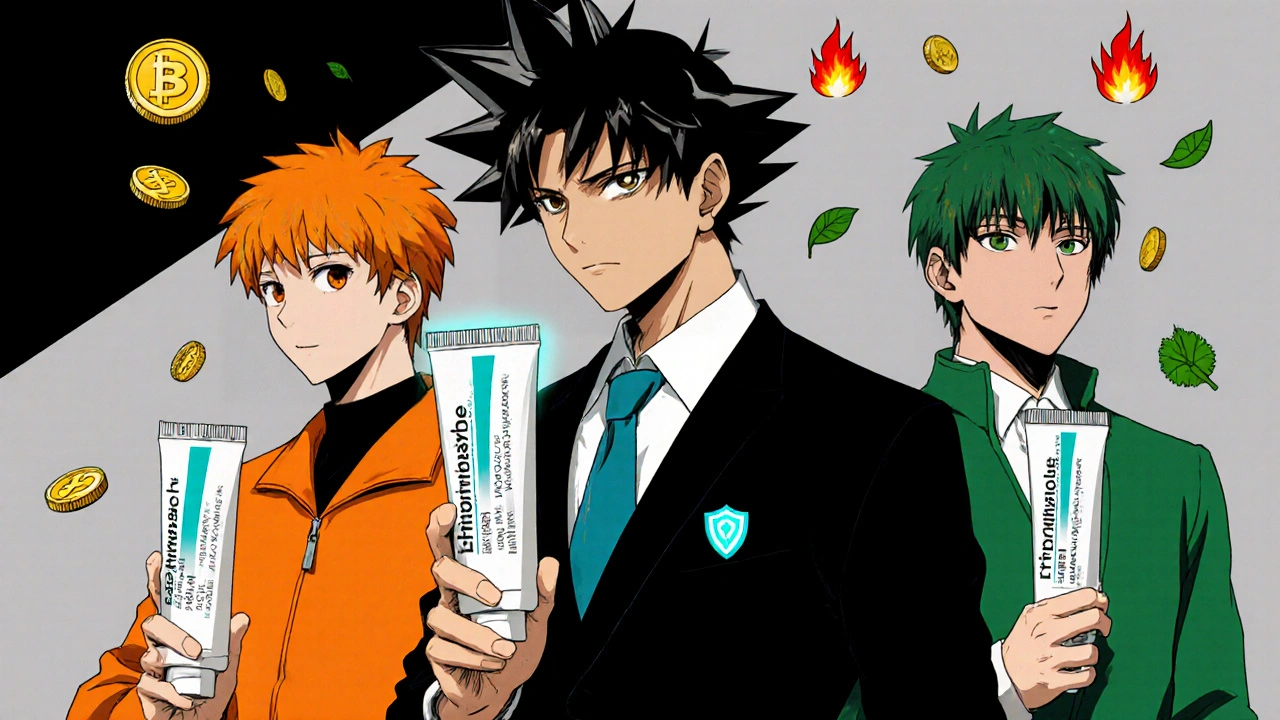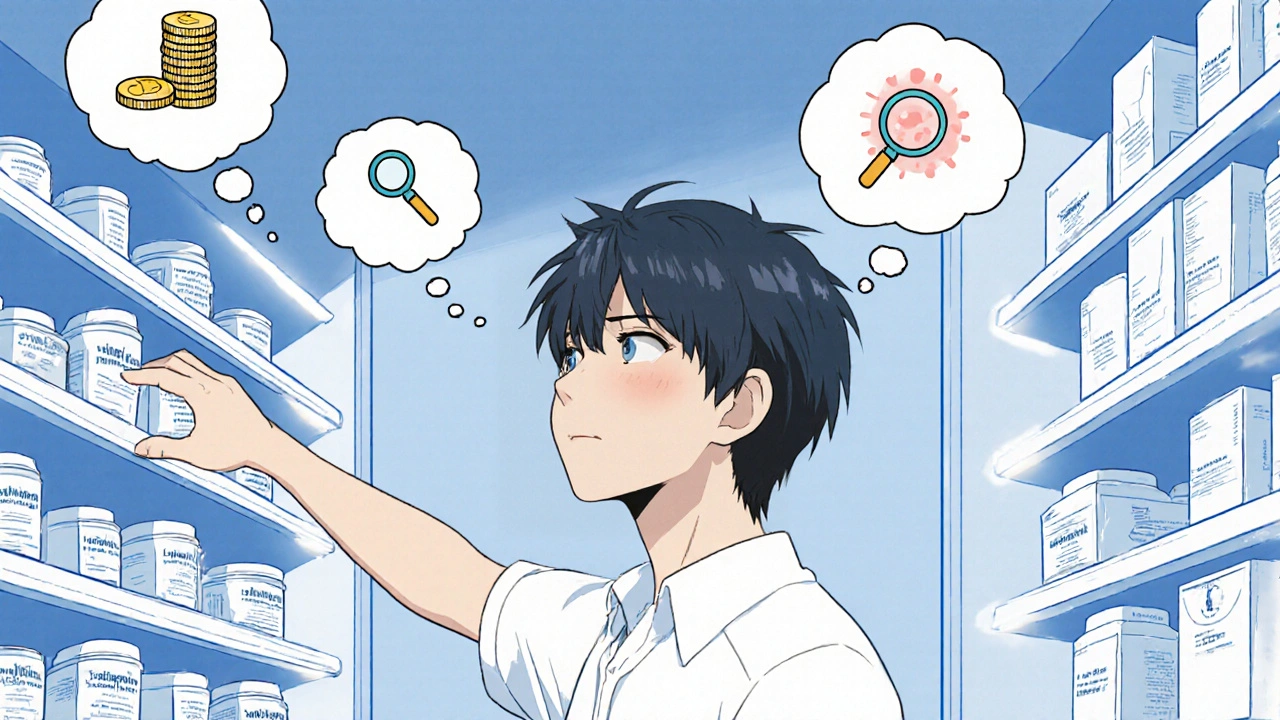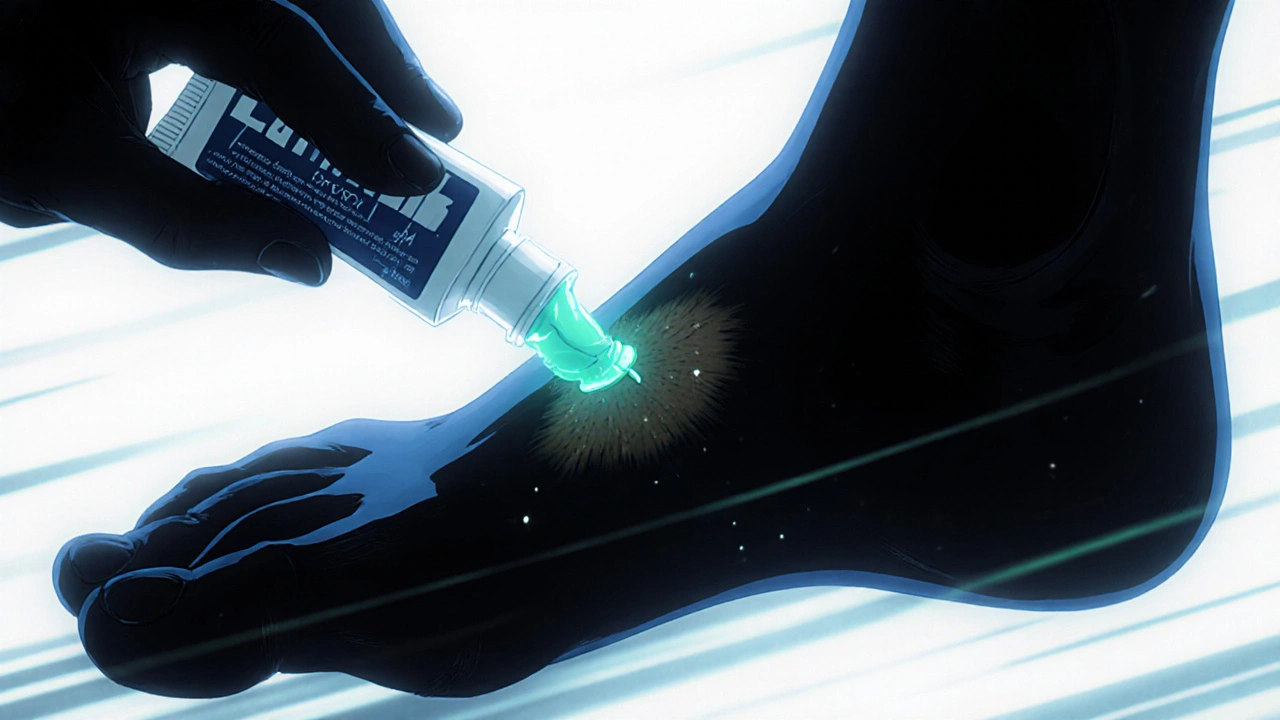Antifungal Cream Selector
Find Your Best Antifungal Option
Answer a few questions to get personalized recommendations based on your specific condition and needs.
Recommended Options
Your personalized antifungal recommendations based on your inputs.
Quick Takeaways
- Lamisil Cream (Terbinafine) works fastest for dermatophyte infections but can be pricier than generic options.
- Clotrimazole, Miconazole and Tolnaftate offer similar cure rates for mild cases and are often cheaper.
- Side‑effects are generally mild; however, terbinafine may cause occasional itching or burning.
- Choose based on infection type, cost tolerance, and any known drug sensitivities.
- Always finish the full course, even if symptoms improve early.
How Topical Antifungals Work
When you apply a cream to an infected skin area, the active ingredient penetrates the outer layer (stratum corneum) and attacks the fungal cell wall or its metabolism. Most over‑the‑counter (OTC) creams halt the fungus’s ability to make ergosterol, a key component of the fungal membrane, causing the cell to leak and die. This process takes a few days, which is why you’ll often hear doctors say, “keep using it for two weeks even if it looks better.”
What Makes Lamisil Cream Different?
Lamisil Cream (Terbinafine) is a prescription‑strength topical antifungal that belongs to the allylamine class. It blocks the synthesis of ergosterol, weakening the fungal cell membrane and leading to rapid clearance of dermatophyte infections. Terbinafine is especially effective against Trichophyton species, the culprits behind athlete’s foot, ringworm, and jock itch.
Key attributes
- Typical dosage: Apply a thin layer twice daily for 2-4 weeks, depending on the infection.
- Success rate: Clinical studies show cure rates of 90-95% for common dermatophyte infections.
- Common side effects: Mild burning, itching, or redness at the application site; rare systemic reactions.
- Cost: Around $30-$45 for a 30 g tube in the U.S., though many insurance plans cover it.
Because it’s prescription‑only, you’ll need a doctor’s note, but the higher cure speed can be worth the extra step for stubborn or extensive infections.

Top OTC Alternatives You Can Grab Off the Shelf
Below is a side‑by‑side look at the most popular OTC creams that target the same infections. Each entry gets a brief rundown before the table.
Clotrimazole Cream is an imidazole antifungal that interferes with fungal cell membrane formation, making it a go‑to for mild to moderate cases.
Miconazole Cream works similarly to clotrimazole but has a broader spectrum, covering yeast infections in addition to dermatophytes.
Tolnaftate Cream is a synthetic antifungal that disrupts the fungal cell wall; it’s often marketed for athlete’s foot prevention.
Ketoconazole Cream is a potent azole used for both fungal and some seborrheic dermatitis cases; it’s prescription‑only in some regions.
| Product | Active Ingredient | Typical Use | Success Rate* | Common Side Effects | Approx. Cost (US$) |
|---|---|---|---|---|---|
| Lamisil Cream | Terbinafine 1% | Athlete’s foot, ringworm, jock itch | 90-95% | Burning, itching | 30-45 |
| Clotrimazole Cream | Clotrimazole 1% | Athlete’s foot, ringworm | 80-90% | Redness, mild irritation | 5-10 |
| Miconazole Cream | Miconazole 2% | Athlete’s foot, jock itch, yeast infections | 82-92% | Itching, dryness | 6-12 |
| Tolnaftate Cream | Tolnaftate 1% | Prevention & early treatment of athlete’s foot | 75-85% | None to mild irritation | 4-8 |
| Ketoconazole Cream | Ketoconazole 2% | Seborrheic dermatitis, fungal infections | 85-92% | Burning, dryness | 15-20 (prescription) |
*Success rates are drawn from FDA‑approved clinical trial data and peer‑reviewed studies up to 2024.
How to Pick the Right Antifungal Cream for You
Think of your choice as a mini‑checklist. Answer these questions and you’ll land on the best option.
- What type of fungus? If a doctor confirmed a dermatophyte, terbinafine often wins. For yeast‑related issues, miconazole shines.
- How extensive is the infection? Large or thick‑skinned areas (like the soles) respond better to potent agents like terbinafine.
- Budget constraints? OTC alternatives can be 5-10× cheaper than prescription creams.
- Allergy history? If you’ve reacted to imidazoles (clotrimazole, miconazole), steer toward terbinafine or tolnaftate.
- Insurance coverage? Some health plans cover Lamisil with a prior‑auth, lowering out‑of‑pocket cost.
Match your answers to the table above, and you’ll have a clear direction.

Common Pitfalls & Pro Tips
Never skip the loading dose. Even if the rash fades after three days, continue the full treatment length to avoid relapse.
Apply to clean, dry skin. Moisture blocks absorption, making the cream less effective.
Watch for cross‑reactions. People using topical steroids nearby may see increased irritation; separate the applications by at least an hour.
Store properly. Keep creams at room temperature, away from direct sunlight, to preserve potency.
Frequently Asked Questions
Can I use Lamisil Cream without a prescription?
In the U.S., Lamisil Cream is classified as prescription‑only, so you’ll need a doctor’s note. Some countries sell it OTC, but always check local regulations.
How long before I see results?
Most users notice reduced itching and redness within 3‑5 days, but the fungus can take 2‑4 weeks to fully clear.
Is it safe to use Lamisil Cream on children?
The FDA approves terbinafine cream for ages 2 and up, but apply only a thin layer and watch for irritation. Consult a pediatrician if you’re unsure.
What’s the biggest advantage of tolnaftate over Lamisil?
Tolnaftate is cheap, OTC, and great for prevention. It’s ideal for athletes who want a low‑cost shield against recurring foot fungus.
Can I switch from an OTC cream to Lamisil mid‑treatment?
Yes, but finish the current course of the OTC product or consult your dermatologist to avoid overlapping side‑effects.
Armed with this comparison, you can pick the antifungal that fits your needs, budget, and skin type. Remember: the best cure is the one you actually finish.





Lindy Hadebe
October 24, 2025 AT 13:41Lamisil is overpriced for what it does.
HILDA GONZALEZ SARAVIA
October 25, 2025 AT 11:08If you’re battling a stubborn athlete’s foot, the prescription‑strength of terbinafine can shave a few days off the healing timeline. For mild cases, though, a clotrimazole or miconazole over‑the‑counter tube does the job just fine and saves you a bunch of cash. Remember to apply the cream to clean, dry skin and keep it on for the full two‑week course even if it starts looking better early. That way you avoid the dreaded relapse that’s all too common with half‑hearted treatment.
Amanda Vallery
October 26, 2025 AT 08:17OTC creams like tolnaftate are cheap and work decently for early‑stage fungus. Just don’t expect them to clear thick‑skinned infections as fast as terbinafine.
Marilyn Pientka
October 27, 2025 AT 05:27The pharmacodynamics of allylamines such as terbinafine confer a rapid fungicidal effect by targeting squalene epoxidase, a pivotal enzyme in ergosterol biosynthesis. This mechanistic specificity translates into higher mycologic cure rates compared to the broader‑spectrum imidazoles. However, the trade‑off resides in the prescription barrier and a marginally elevated risk of localized dermal irritation. From a health‑economics perspective, the incremental cost is justified only when the infection burden is substantial or recalcitrant. In routine, low‑grade dermatophytosis, a cost‑effective imidazole or tolnaftate regimen remains clinically acceptable.
Jordan Levine
October 28, 2025 AT 02:38Honestly, you should just grab the Lamisil and finish the battle! 💪🔥 No need to waste time with cheap knock‑offs when you can win fast.
Carla Taylor
October 28, 2025 AT 23:48Good luck finding a better cure!
Kathryn Rude
October 29, 2025 AT 21:01While some may worship the price tag, the true measure lies in therapeutic efficacy-Lamisil delivers, no doubt. :)
Michelle Capes
October 30, 2025 AT 18:14Totally get the frustration-budget matters, but the cure matters more. Hope you find the right balance! 😊
Dahmir Dennis
October 31, 2025 AT 15:28Let’s put this discussion into perspective: the sheer volume of half‑hearted attempts at treating dermatophyte infections is a public health embarrassment. People slather cheap creams, abandon them after three days, and then wonder why the rash returns with a vengeance. The underlying problem isn’t the antifungal agent; it’s human negligence. When you ignore the pharmacokinetic principle that the drug must fully eradicate the fungal hyphae, you’re essentially inviting a relapse. Moreover, the sheer variety of over‑the‑counter options creates analysis paralysis, leading many to make uninformed choices. A prescription‑only formulation like terbinafine forces a clinician into the decision‑making loop, ensuring the patient receives a regimen tailored to the pathogen’s species. This gatekeeping reduces misuse and mitigates resistance development, a concern that’s often brushed aside. The data are unequivocal: cure rates for terbinafine hover around 93 %, whereas average OTC treatments languish in the 80 % range. That differential is not trivial when considering the cumulative burden of chronic fungal infections across the population. Additionally, the side‑effect profile of terbinafine is remarkably benign, limited mostly to transient burning or itching at the site. Contrast that with the occasional dermatitis flare from imidazoles, which can be more irritating than the infection itself. The economic argument also favors a definitive cure; a single course of Lamisil may cost $40, but the cost of repeated OTC courses, doctor visits, and lost productivity adds up quickly. In the grand scheme, prescribing terbinafine is a cost‑effective strategy that aligns with evidence‑based medicine. So before you dismiss it as “just another pricey cream,” consider the broader implications of incomplete treatment. The stakes are higher than a minor inconvenience; they touch on antimicrobial stewardship, patient quality of life, and overall healthcare expenditures. In short, effective, complete treatment trumps cheap, half‑baked attempts every time.
Jacqueline Galvan
November 1, 2025 AT 12:37For the benefit of readers seeking a concise recommendation, Lamisil remains the optimal choice for confirmed dermatophyte infections, provided insurance coverage or a prescription is attainable. Should cost constraints dominate, clotrimazole and miconazole present respectable alternatives with slightly lower cure rates. Adherence to the full therapeutic course is paramount regardless of the selected agent.
Tammy Watkins
November 2, 2025 AT 09:47While the preceding exposition emphasizes clinical efficacy, it is equally vital to acknowledge patient adherence dynamics. The psychological burden of prolonged treatment can precipitate premature discontinuation, undermining therapeutic outcomes. Accordingly, clinicians should counsel patients on realistic timelines and the necessity of sustained application. Additionally, integrating patient education about skin hygiene can synergistically enhance antifungal potency. In sum, the therapeutic success hinges not solely on the pharmacologic agent but also on the patient's commitment to the regimen.
Dawn Bengel
November 3, 2025 AT 06:59Only true patriots trust the tried‑and‑true Lamisil-nothing else will do for our great nation’s foot health! 🇺🇸💥
junior garcia
November 4, 2025 AT 04:10Use the cream on clean skin and keep it dry. That’s the real secret.
Teya Arisa
November 5, 2025 AT 01:21From a professional standpoint, it is advisable to follow the prescribed duration to forestall recurrence; adherence is the linchpin of success. 😊
Kester Strahan
November 5, 2025 AT 22:33FYI, the minimal inhibitory concentration (MIC) for terbinafine is lower than for clotrimazole, which means you need less drug to stop fungal growth. Just a heads‑up if you’re diving into the data.